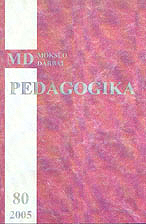The Development of Tense-Aspect in English as a Second Language
The Development of Tense-Aspect in English as a Second Language
Author(s): Jurgita TrapnauskienėSubject(s): Education
Published by: Vytauto Didžiojo Universitetas
Keywords: tense-aspect; english; second language
Summary/Abstract: Language acquisition is one of the central topics in cognitive science. An important domain of extensive study in second language research has been the development of temporal-aspectual systems in interlanguage. Bardovi-Harling points out that “two main strands of inquiry can be distinguished: the investigation of the expression of semantic concepts through various linguistic devices and the investigation of distribution of verbal morphology as an indicator of the underlying semantic system of interlanguage” [3, p. 194]. MacWhinney distinguishes two subtasks in the language learner’s task of mastering the tense-aspect (TA) system of his target language. They, although being linked, need not proceed in tandem (MacWhinney, 1978): 1. A form-to-form mapping task, i. e. learning the various verb form categories and morphological paradigms of the TL; 2. A form-to-function mapping task, i. e. learning the relevant temporo-grammmatical meanings and discourse-pragmatic functions that are obligatory or optionally expressed in the TL, and mapping these onto their appropriate morphological forms [4, p. 155]. Most studies in second language acquisition, especially the aspect studies, concentrate on the Aspect Hypothesis. The aspect hypothesis has its roots in theories of temporal semantics and in SLA research it is related to research in child language acquisition. The aspect hypothesis is based on a theory of lexical, or inherent, aspect. In contrast to the more widely recognized grammatical aspect, which is typically morphological (such as the simple past and past progressive in English), inherent aspect is a purely lexical, non-grammatical category (Binnick, 1991) [3, p. 193]. Grammatical aspect, also known as viewpoint aspect, provides different ways of viewing situations. Lexical aspect, known as inherent aspect, refers to the inherent semantic properties of the linguistic expression used to refer to a situation. These semantic properties are aspectual in nature and are most commonly defined in terms of Vendler’s model of inherent verb semantics. The version of Vendler’s model with widest currency in L2 research distinguishes four predicate types, depending on whether it is stative or dynamic, punctual or durative, and telic or atelic. Thus, states (STA) are +stative, +durative, -telic (i. e. be, want, know); activities (ACT) are –stative, +durative, -telic (i.e. play, work. laugh); accomplishments (ACC) are –stative, +durative, +telic (i.e. explain, prepare, grow up); achievements (ACH) are –stative, –durative, + telic (i.e. kill, drop, catch) [1, p. 311; 6, p. 101–102]. In this article an experimental study investigating the ways in which Lithuanian learners of English as a second language connect form and meaning in the temporal and aspectual domain is reported.
Journal: Pedagogika
- Issue Year: 2005
- Issue No: 80
- Page Range: 51-56
- Page Count: 6
- Language: English

